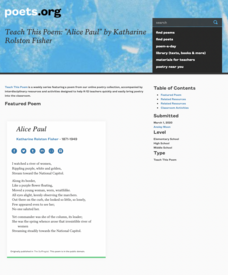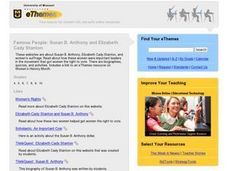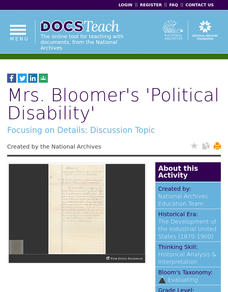Newseum
Things Change, Things Stay the Same
Securing women the right to vote was a long time coming. Over the years, some aspects of the suffrage movement changed, and some things remained the same. Pupils research three time periods and collect evidence of key people, strategies,...
National Woman's History Museum
The Power of Words and Activism: Susan B. Anthony
Where have all the activists gone? Class members compare 21st-century activism with the suffrage movement and the work of Susan B. Anthony. They begin by examining Anthony's biography and speeches to find evidence that her words and...
Newseum
Persuasion Portfolios
After class members brainstorm a list of current social and political issues, groups each select a different topic from the list to research. Teams create a portfolio of at least 10 examples of stories about their issue, stories that...
DC Vote
One Kid, One Vote
Learn about why the citizens of Washington, D.C. feel unrepresented in Congress with an article about D.C voting rights. Individuals read about the movement toward congressional representation in Washington, D.C., before answering...
NPR
Progressive Era Lesson Plan
The women working for equal rights in the early 20th century weren't a part of one large group; rather, they were members of dozens of small groups focused on social reform. Explore the ways groups in the Progressive Era like National...
Curated OER
The New Woman: The Turn of the Century
According to this slide show, it all started with ladies riding bikes. The symbol of the woman as an independent and self-moving entity led turn of the century ladies into leaders for female independence. Discussed are women who changed...
Curated OER
Women's Rights and Reform
Students evaluate primary source documents. They assess the development of women's rights in the United States. They identify other rights beside suffrage that were important to famous women reformers.
National Woman's History Museum
From the Declaration of Independence to the Declaration of Sentiments
As part of a study of women's rights in early America, class members compare the Declaration of Independence to the Declaration of Sentiments presented at the Seneca Falls Convention. As an exit ticket, individuals explain whether or not...
Academy of American Poets
Teach This Poem: "Alice Paul" by Katharine Rolston Fisher
Powerful women need not look like Wonder Woman. After writing a paragraph about a strong woman they know, young scholars examine images of Alice Paul and then do a close reading of Katharine Rolston Fisher's poem "Alice Paul." Finally,...
Curated OER
Elizabeth Cady Stanton, Suffragist
Students examine one woman's impact on a nation. In this suffragette lesson, students are introduced to Elizabeth Cady Stanton and examine her involvement in both the anti-slavery and woman's movement. Students compare the Declaration...
Curated OER
Women in Progressive Era
Students study the Progressive Era. They identify the important people, places, and evens of the Era and determine how women influenced the progressive movement. In addition, they create an article to address issues related to the movement.
US National Archives
Documented Rights Educational Lesson Plan
How have groups struggled to have their unalienable rights recognized in the United States? Acting as a research team for the Human Rights Council of the United Nations, your young historians will break into groups to research how people...
Curated OER
FAMOUS PEOPLE: SUSAN B. ANTHONY AND ELIZABETH CADY STANTON
Students explore websites are about Susan B. Anthony, Elizabeth Cady Stanton, and women's suffrage and read about how these women were important leaders in the movement that got women the right to vote.
Facing History and Ourselves
The Audacity of a Vote: Susan B. Anthony’s Arrest
Susan B. Anthony's speech "Is It a Crime for Women to Vote?" takes center stage in a lesson that asks class members to consider how they might respond to what they consider an unjust law. Groups work through the speech paragraph by...
US House of Representatives
A Picture Is Worth a Thousand Words
As part of a study of women in Congress, groups analyze historical photographs associated with women's history and with women senators and representatives.
Stanford University
Anti-Suffragists
Young scholars view the movie Iron Jawed Suffragists.In this anti- suffragists lesson, students recognize that many people didn't want women's suffrage. Young scholars view documents written about suffrage and create a graphic organizer.
National Woman's History Museum
Seneca Falls Convention
The 1848 Seneca Falls Convention was a historic milestone in the quest for women's rights. After researching one of the participants of the Seneca Falls Convention, young historians craft and share a short presentation about their subject.
Smithsonian Institution
The Suffragist: Educator's Guide for Classroom Video
Class members take on the role of historical investigators to determine why it took 40 years for women in the United States to get the right to vote. Sleuths view videos and analyze primary sources and images to gather evidence to answer...
DocsTeach
Mrs. Bloomer's 'Political Disability'
It's hard to believe that women had to argue for the right to vote a mere 100 years ago. Today, young historians can examine their case left behind in primary sources. Using a letter from a woman who claimed she should be able to vote...
DocsTeach
Fannie Lou Hamer and Voting Rights
To understand the challenges Black voters faced in Mississippi, middle schoolers first gather background information about Fannie Lou Hamer and then read her testimony given during the 1964 Democratic Nation Convention. After a...
PBS
Elizabeth Cady Stanton: Orator, Author, and Activist
Have you ever felt like your opinion doesn't count? Scholars research and analyze the impact Elizabeth Cady Stanton had on women's rights. Primary and secondary sources as well as video clips give individuals a clear picture of Stanton's...
New York State Education Department
US History and Government Examination: June 2010
Just how successful were the reform movements of the ninteenth and twentieth centuries? Using documents ranging from the writings of Mother Jones to the marriage vows of Lucy Stone, individuals consider the question in a scaffolded...
National Woman's History Museum
Country to City
After reading a series of primary source documents, groups compare the lives of and opportunities available to rural and urban women in the 19th century to rural and urban life in the 21st century. As an exit ticket, individuals craft a...
National Woman's History Museum
State vs. Federal Campaigns
Campaigns to gain voting rights for women during the 19th and 20th centuries took place on both the state and federal level. After examining primary sources that document both types of campaigns, class members debate the merits of the...

























